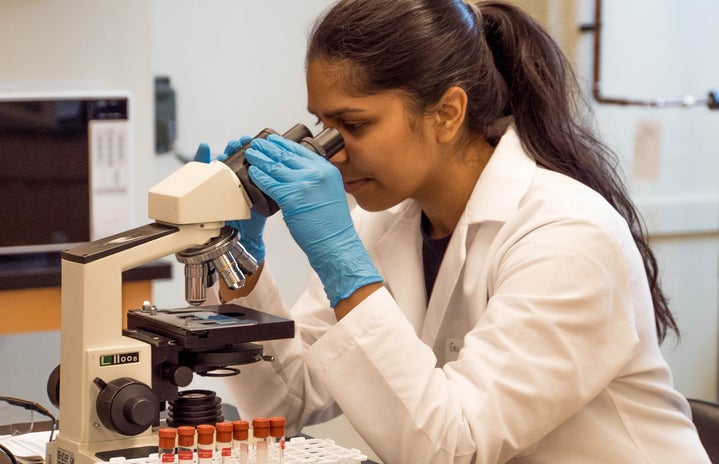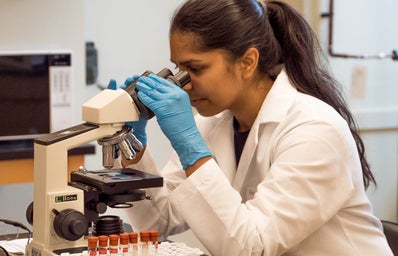Women have been making contributions to science for centuries but unfortunately, they haven’t always gotten the recognition they deserve. Men have dominated the STEM fields overshadowing women and sometimes taking credit for their findings. Here are three women who made significant findings and conducted groundbreaking research and deserve to be recognized.
- Rosalind Franklin
-
Everyone knows that the structure of DNA is in the shape of a double helix. When I learned about DNA’s structure in my general biology college course, I was taught it was called the Watson- Crick DNA model because James Watson and Francis Crick were the ones who discovered the structure’s shape. While this is true, it never would have been possible without Rosalind Franklin’s research.
Franklin was awarded a fellowship to work in John T. Randall’s Biophysics Unit at King’s College London in the year 1950. She worked alongside Maurice Wilkins, who was a lab assistant. Wilkins wanted to work with Franklin on X-Ray Crystallography, which is a technique used to determine the 3D structure of large, biological molecules.
Wilkins did not communicate his desires well enough and Franklin ended up working on DNA’s structure with Raymond Gosling, a graduate student.
Franklin began becoming more and more successful at taking clear images of the structure of DNA and was able to determine that it had two helices.
Meanwhile, Watson and Crick had ideas and a theoretical model of DNA but were not collaborating with Franklin. They were able to determine the full structure of DNA after Wilkins showed them Franklin’s unpublished work. They were then able to publish their findings and solidify themselves in biological history.
Watson, Crick, and Wilkins all received a Nobel Prize for Physiology and Medicine in 1962 and never gave any credit to Franklin.
- Lise Meitner
-
Lise Meitner was an Austrian physicist who aided in the discovery of nuclear fission.
She was a trailblazer in many ways. She was the second female to receive a doctorate at the University of Vienna in 1906 and the first woman to become a physics professor at the University of Berlin in 1926.
Otto Hanh and Meitner worked closely on research together for 30 years. Hanh was a chemist and with their two areas of study combined they were able to discover the isotope of protactinium and the cause of the Auger effect before World War II.
She then began her research on nuclear fission in 1926. Many scientists were researching this at the time, all seeking a Nobel Prize.
Once WWII broke out, Mitner had to leave Germany to escape the Nazi Party. She continued to converse with her colleagues in Germany.
Eventually, Hanh discovered the evidence for nuclear fission but Meitner was the one who was able to explain it. Hanh was quick to take her explanation and take all the credit and the Nobel prize for himself. He never acknowledged her contribution to this discovery.
Meitner and Hanh’s research was what prompted the start-up of The Manhattan Project, the production of the atomic bombs.
Meitner foresaw the devastating effects these nuclear weapons would have and refused to have any part of the project.
- Eunice Foote
-
One of the biggest problems that humanity faces today is climate change. The greenhouse effect is heat entering the earth’s atmosphere from the sun. Greenhouse gases such as CO2 and Methane exist in our atmosphere to insulate the earth. This is essential to keep the earth’s temperatures warm so that life is possible on our planet.
The warming of the earth’s temperature occurs when there are too many greenhouse gases in our atmosphere and heat isn’t able to escape. This was discovered by John Trynadall, the founding father of climate change science… or so we thought.
Eunice Newton Foote was a trailblazer for the Women’s Rights Movement in 1948 and signed the manifesto for women’s rights, The Declaration of Sentiments. While a well deserved and important recognition, this was all she would be known for until 2010.
Raymond Sorenson, a collector of old technical books, was reading a copy of Annual Scientific Discovery from 1857.
He discovered Foote’s published study called Circumstances Affecting the Heat of the Sun’s Rays.
Foote was an amateur scientist because degrees were difficult to pursue as a woman at the time.
In her study, she described an experiment that she conducted that simulated the earth and its atmospheres with glass cylinders. She describes the warming effects of an excess of CO2. Noting how much warmer the glass cylinder became and how much longer it took to cool down.
In 1859, Tyndall would discover this through his own experiment and publish his findings. It is unknown whether not Tyndall knew of Foote’s findings.
You may be wondering why Foote never got the recognition she deserved. Well, her study was read aloud on August 23, 1856 to the American Association for the Advancement of Science but she was not allowed to read it herself. Joseph Henry, the secretary for the Smithsonian Institution read her work that day.
Ultimately, Foote’s discoveries were hindered because of the fact that she was a woman.
These women are just a small representation of the great part that women have played in science. They paved the way for women to continue to make discoveries and contributions to the scientific community.
Share your favorite scientific discovery made by a woman @HerCampusSJSU.


